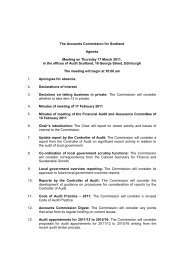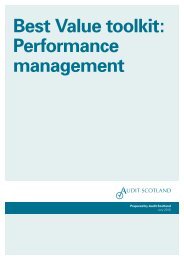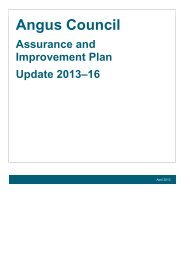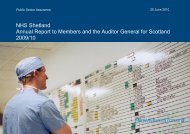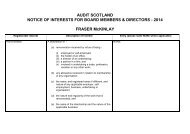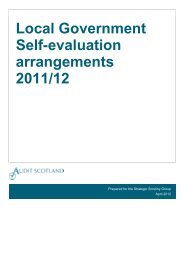Management of the Holyrood building project (PDF ... - Audit Scotland
Management of the Holyrood building project (PDF ... - Audit Scotland
Management of the Holyrood building project (PDF ... - Audit Scotland
You also want an ePaper? Increase the reach of your titles
YUMPU automatically turns print PDFs into web optimized ePapers that Google loves.
72<br />
etc for <strong>the</strong> <strong>Holyrood</strong> <strong>project</strong> (current<br />
estimated outturn cost £68 million).<br />
Project management did not resolve<br />
important questions about <strong>the</strong> basis<br />
<strong>of</strong> each consultant’s fee<br />
remuneration until August 2003<br />
comparatively late in <strong>the</strong> <strong>project</strong>. I<br />
examine this issue later in this part <strong>of</strong><br />
my report.<br />
5.27 Until July 2003, reporting by <strong>the</strong><br />
Accountable Officer to <strong>the</strong> Corporate<br />
Body usually focussed on <strong>the</strong> value<br />
<strong>of</strong> current construction contract<br />
commitments and recent awards.<br />
Because no budget for <strong>the</strong> overall<br />
cost <strong>of</strong> <strong>the</strong> <strong>project</strong> had been set<br />
<strong>the</strong>re was no routine report or<br />
commentary on overall <strong>project</strong> costs<br />
and trends or <strong>the</strong> constituent<br />
elements, relative to what would be<br />
in any budget.<br />
5.28 In any <strong>project</strong> it is important<br />
that all <strong>the</strong> parties have a clear<br />
understanding <strong>of</strong> how budget, risk<br />
and contingency relate to each<br />
o<strong>the</strong>r:<br />
• A budget is an approved sum<br />
allocated for a <strong>project</strong> (a pot <strong>of</strong><br />
money). Only <strong>the</strong> authority that<br />
approves a budget can vary it<br />
once set. A budget is not <strong>the</strong><br />
same as a forecast, which will<br />
vary through <strong>the</strong> life <strong>of</strong> <strong>the</strong> <strong>project</strong><br />
as circumstances unfold.<br />
• A risk is an event that may occur<br />
and may have an impact on <strong>the</strong><br />
outcome <strong>of</strong> <strong>the</strong> <strong>project</strong>.<br />
• A contingency is an allowance<br />
within <strong>the</strong> budget for unidentified<br />
costs, including risks. Similarly a<br />
forecast is likely to include a<br />
contingency.<br />
5.29 At different times <strong>project</strong><br />
management and <strong>the</strong> Progress<br />
Group acted to contain or reduce<br />
costs. However <strong>the</strong> normal financial<br />
discipline <strong>of</strong> named individuals being<br />
accountable for controlling<br />
expenditure within limits specified in<br />
an approved budget was not present<br />
on this <strong>project</strong>. It seems that <strong>project</strong><br />
management regarded <strong>the</strong> regular<br />
reports from <strong>the</strong> cost consultant on<br />
construction costs and on risk costs<br />
as setting a construction budget,<br />
when <strong>the</strong>y were no more than<br />
forecasts. An example <strong>of</strong> this is that<br />
before payment <strong>project</strong> management<br />
checked each trade contractor’s<br />
invoice to ensure it did not raise total<br />
payments above <strong>the</strong> total estimated<br />
cost for <strong>the</strong> package reported by <strong>the</strong><br />
cost consultant. The danger <strong>of</strong><br />
confusing forecasts with budgets is<br />
that forecasts will become selffulfilling<br />
if effective action is not taken<br />
to contain <strong>the</strong> cost.<br />
5.30 Exhibit 47 illustrates how <strong>the</strong><br />
estimated construction costs<br />
including risk reported to <strong>the</strong><br />
Progress Group and <strong>the</strong> Parliament<br />
have steadily increased since 2000.<br />
Generally estimated construction<br />
expenditure and construction risk<br />
costs reported to <strong>the</strong> Parliament has<br />
initially been lower but has <strong>the</strong>n risen<br />
to <strong>the</strong> same level as <strong>the</strong> cost<br />
consultant’s forecast.<br />
The approach to risk management<br />
was not fully consistent with good<br />
practice<br />
5.31 In my 2000 report I concluded<br />
that accounting for risk was<br />
insufficient. I showed that contrary to<br />
good practice <strong>the</strong>re was no<br />
quantified allowance for <strong>the</strong> major<br />
risks facing <strong>the</strong> <strong>project</strong>. I<br />
recommended that this should be<br />
established and <strong>the</strong> results used as a<br />
basis for an action plan to manage<br />
<strong>the</strong> risks.<br />
5.32 In Part 2 <strong>of</strong> this report I show<br />
that <strong>project</strong> management introduced<br />
a process for quantifying risks from<br />
October 2000 and has conducted risk<br />
reviews since <strong>the</strong>n. However in<br />
some important respects risk<br />
management for <strong>the</strong> <strong>Holyrood</strong><br />
<strong>project</strong> has not been consistent with<br />
good practice. Under <strong>the</strong> draft <strong>project</strong><br />
execution plan prepared in October<br />
2000 it was <strong>project</strong> management’s<br />
responsibility to arrange and convene<br />
risk management meetings at<br />
relevant intervals to review progress<br />
on all aspects <strong>of</strong> risk as <strong>the</strong>y affected<br />
<strong>the</strong> <strong>project</strong>.<br />
5.33 Twelve risk workshops did take<br />
place, between October 2000 and<br />
December 2002. In accordance with<br />
good practice representatives from<br />
<strong>project</strong> management, <strong>the</strong> design<br />
team and <strong>the</strong> cost consultants<br />
participated. An experienced risk<br />
management specialist employed by<br />
<strong>the</strong> cost consultant led <strong>the</strong>se events,<br />
in accordance with <strong>the</strong> cost<br />
consultant’s contractual responsibility<br />
to undertake and lead risk<br />
assessments as part <strong>of</strong> its service.<br />
5.34 A fundamental feature <strong>of</strong> risk<br />
management is to allocate or assign<br />
each risk to whichever party is best<br />
placed to manage it. Usually a named<br />
individual or party (an owner) is<br />
assigned to mitigate or manage out<br />
<strong>the</strong> risk, with <strong>the</strong> aim to lead action<br />
to eliminate, or at least reduce <strong>the</strong><br />
impact <strong>of</strong>, specific risks and <strong>the</strong>refore<br />
minimise expenditure on<br />
‘contingency’ or ‘risk allowance’.<br />
5.35 Although <strong>the</strong> risk workshops for<br />
<strong>the</strong> <strong>Holyrood</strong> <strong>project</strong> did identify<br />
owners for specified risks <strong>the</strong>re was<br />
no monitoring or feedback on<br />
subsequent action. It is not clear that<br />
<strong>the</strong> workshops from 2000 to<br />
December 2002 succeeded in <strong>the</strong><br />
aim to reduce or manage risks out.<br />
5.36 From December 2002 risk<br />
management operated differently.<br />
There were no fur<strong>the</strong>r workshops<br />
with <strong>the</strong> previous wide participation.<br />
There was <strong>the</strong>reafter no systematic<br />
basis for any action by <strong>project</strong>



